Medieval-style map of Mars

From Eleanor Lutz, a gorgeous medieval-style map of Mars.



This site is made possible by member support. 💞
Big thanks to Arcustech for hosting the site and offering amazing tech support.
When you buy through links on kottke.org, I may earn an affiliate commission. Thanks for supporting the site!
kottke.org. home of fine hypertext products since 1998.
If you’ve ever pulled a door that you should have pushed, you’re not alone. Vox and 99% Invisible collaborated on this video about bad door design. I read Don Norman’s The Design of Everyday Things just as I was starting my design career and it probably had more influence than anything in how I approached designing for the web. (via @ophelea23)
Chris Rock opened his monologue at the Oscars last night with “I’m here at the Academy Awards, otherwise known as the White People’s Choice Awards” and for the next ten minutes, talked about racism in Hollywood.
Update: As much as I enjoyed Rock’s monologue, I also agree with Stacia Brown’s piece, Chris Rock, Justice for Flint and why we still have ‘real things to protest’.
We still have real things to protest. If water contamination in a U.S. city due to alleged negligence doesn’t call for “real” protest, what does? Disinvestment in the Oscars — especially for DuVernay and Coogler — isn’t a frivolous undertaking. And black performers don’t want equal opportunity just to be considered for awards. In this country, celebrity has always afforded people the platform and the capital to push forward the issues that are important to them. There couldn’t have been a Justice for Flint fundraiser on the scale that they were able to mount without star power. Black celebrity — its acknowledgement and its compensation — is significant.
(via @anildash)
On Last Week Tonight last night, John Oliver took on the #brand running for President known as Donald Trump. Or, as he would have been known had one of his ancestors not changed his last name, Donald Drumpf. If you’d like to play along at home, you can install the Drumpfinator Chrome extension, which will replace any mentions of “Trump” on the web with “Drumpf”.
For his series on character actors called No Small Parts, Brandon Hardesty profiles the incomparable Crispin Glover. (via waxy)
Henry Darger is perhaps the most famous outsider artist in the world. This is a short documentary about his life (not much is known) and art (which now fetches tens of thousands of dollars).
From Candice Drouet, a short film called Last Word, a story told with the last words from 129 movies.
From Pantheon at MIT, an adjustable graph of which kinds of people were globally famous in different eras. Up until the Renaissance, the most well-known people in the world were mostly politicians and religious figures, with some writers and philosophers thrown in for good measure:
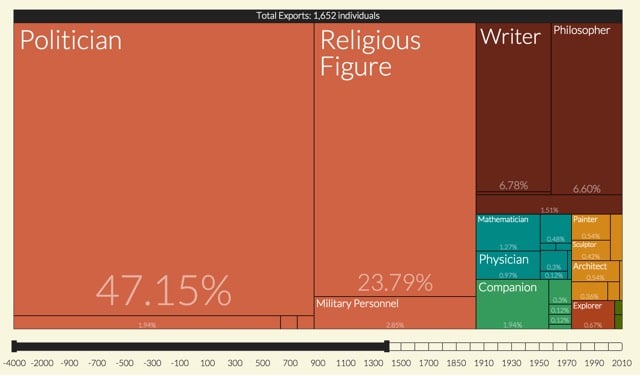
Starting with the Renaissance through the beginnings of the Industrial Revolution, politicians, writers, painters, and composers become more prominent:
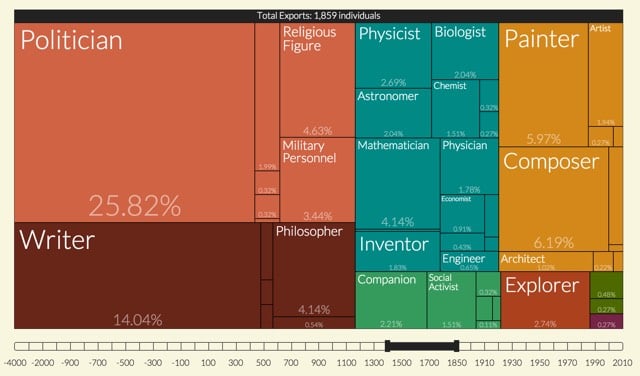
For the past 50 years, athletes and entertainers dominate the list, with footballers making up almost a third of the most known. (If you only go back to 1990, actors dominate.)

Politicians rate slightly behind tennis players (but ahead of pornographic actors) and religious figures are not represented in the graph at all.
If you’re curious about the data, you can read about their methodology and sources.
In 2009, Curb Your Enthusiasm centered on Larry David doing another season of Seinfeld. The four main Seinfeld stars (plus Newman) were all on the show, in character. From the various clips and bits shown, Topher Grace edited together a nine-minute “missing” Seinfeld episode. It’s actually pretty good. I didn’t know how much I’d missed the show until I watched this. (thx, greg)
As you can tell from whatever “outfit” I’ve extracted from my closet and placed on my body each morning, I know close to nothing about fashion. But I love reading about it. This piece about circa-2016 fashion trends in Tokyo neighborhood of Harajuku is interesting in many ways. Take the first section on Genderless Kei and Kawaii Boys.

Though the Kawaii Boys’ styles vary, the most popular look is childlike rather than traditionally feminine. These are not crossdressers, most of them are not gay, and they are not trying to look like — or pass as — women. They are specifically aiming for a happy fun Genderless style. That said, none of these new generation of Kawaii Boys are afraid of incorporating traditionally female fashion elements and makeup into their looks.
When I typically think of genderless fashion, I think of someone dressing “in between” the two dominant genders in relatively nondescript drab clothing that leans masculine. So it’s interesting to see the different approach described here…men wearing traditionally feminine clothes to average out as genderless.
As odd as it sounds, Japanese-ness is also making a comeback in Japanese fashion:
Fashion designers may have finally gotten his message, as we’ve never seen as many Japanese characters in street fashion as we did in 2015. The kanji print boom was just one of the many signs that young Japanese creatives are looking inward as well as outward for inspiration.
The classic Japanese sukajan (souvenir jacket) has been ubiquitous on the streets of Harajuku and in vintage shops since the end of summer. As Spring approaches, the low cost trend shops are well stocked with souvenir jackets as well. Influential indie boutique and underground Japanese brands are offering t-shirts, bags, dresses, and accessories printed with messages in kanji, hiragana, and katakana.
The post also delves into economic and city planning territory with sections on tourism and gentrification. (via @moth)
In this installment of Every Frame a Painting, Tony Zhou and Taylor Ramos examine how the Coen brothers shoot characters in their films close up with wide lenses to created empathy and comedy.
Watch as a honey badger uses everything at his disposal (rocks, mud, trees, tunnels) to escape a supposedly unescapable enclosure. I was aware honey badgers don’t give a shit, but I didn’t know they were so clever.



Valerio Vincenzo’s project, Borderline, the Frontiers of Peace, consists of photos of the erased borders between countries in Europe’s Schengen Area.
The Schengen Area is the area comprising 26 European countries that have abolished passport and any other type of border control at their common borders, also referred to as internal borders. It mostly functions as a single country for international travel purposes, with a common visa policy.
While visiting friends in France a few years ago, we passed the checkpoint between France and Switzerland several times a day and didn’t even bother taking our passports with us. It felt weird but good. (via @neilhalloran)
With amazing super slow-motion footage of a match head starting to burn as a backdrop, this video explains the chemical reactions involved in lighting a match.
When the match is struck, a small amount of the red phosphorus on the striking surface is converted into white phosphorus, which then ignites. The heat from this ignites the potassium chlorate, and the match head bursts into flame. During manufacture, the match stick itself is soaked in ammonium phosphate, which prevents ‘afterglow’ once the flame has gone out, and paraffin, which ensures that it burns easily.
(via gizmodo)
Skier Candide Thovex goes on another one of his crazy creative ski runs. In this one, he jumps over a helicopter (among other things). I still like his previous video a bit more, although the kids are partial to his Audi commercial, especially the abrupt ending.
Boston Dynamics, creator of the Big Dog prancing robot, has upgraded their Atlas robot, which can walk on two legs, open doors, stack boxes, walk on slippery terrain, recover from being shoved, etc. And everyone’s all HA HA HA TERMINATOR but soon enough the HA HAs will become less hearty and more nervous. It took human ancestors hundreds of thousands of years to evolve from quadrupeds to bipeds and Boston Dynamics has done the same in just a few years.
Mark my words: no good will come of playing box keep-away with robots and treating them like, well, machines. It’s already started…did you notice Atlas didn’t even look behind itself to see if it needed to hold the door for anyone? And you think manspreading on the subway is a problem…wait until we have to deal with robotspreading by robots whose ancestors we shoved with hockey sticks.
Update: The hockey stick is back, accompanied by some “robust” tail pulling:
When the entire corpus of YouTube casually becomes a training ground for “young” AI programs, the bots are going to watch this and be all like, “WTF!?” and it’s gonna be on.
As an unapologetic fan of Downton Abbey and Maggie Smith, I quite enjoyed this video compilation of the Dowager Countess’ best burns from all six seasons of Downton Abbey. If you’re having DA withdrawals now that the show is over,1 I encourage you to check out Gosford Park. Robert Altman directed it, Downton creator Julian Fellowes wrote it, and it features Maggie Smith as a snooty Countess — not to mention Clive Owen as a dishy valet. Scrumptious!
Well, almost over in the US..it’s been done in Britain and on the torrents since the start of the year.↩
Aaron Bleyaert lost 80 pounds, got in shape, and wrote about how he did it in four easy steps on his Tumblr.
3.) HAVE YOUR HEART BROKEN
And not just broken; shattered. Into itsy bitsy tiny little pieces, by a girl who never loved you and never will.
Now he’s turned that experience into a short film that showed at Sundance. Watch for the Conan O’Brien cameo.


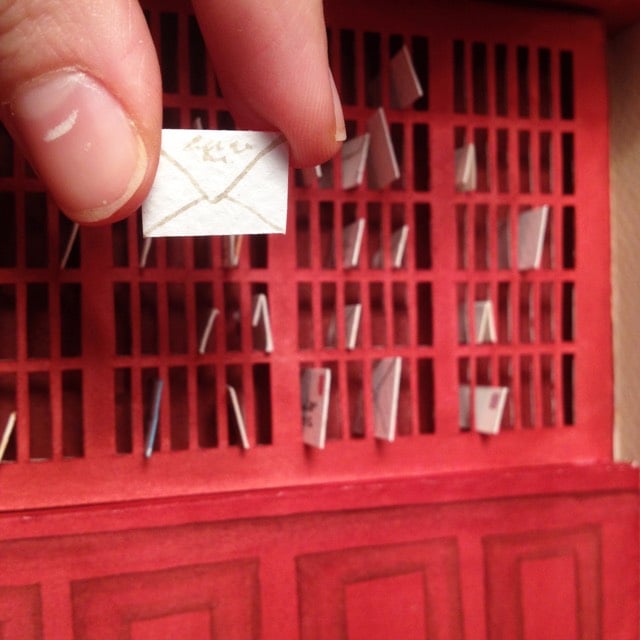
Spanish artist Mar Cerdà uses watercolor and paper to create amazingly detailed dioramas, including those made from scenes in Wes Anderson movies. So far, he’s done scenes from The Grand Budapest Hotel, The Darjeeling Limited, and The Royal Tenenbaums. (via designboom)
When the song that became Thriller was first considered for the album that also became Thriller, it was called Starlight and had totally different lyrics.
We need some starlight starlight sun
There ain’t no second chance we got to make it while we can
You need the starlight some starlight sun
I need you by my side you give me starlight starlight tonight yeah
Songwriter Rod Temperton explains:
Originally, when I did my Thriller demo, I called it Starlight. Quincy said to me, ‘You managed to come up with a title for the last album, see what you can do for this album.’ I said, ‘Oh great,’ so I went back to the hotel, wrote two or three hundred titles, and came up with the title ‘Midnight Man’. The next morning, I woke up, and I just said this word… Something in my head just said, this is the title. You could visualise it on the top of the Billboard charts. You could see the merchandising for this one word, how it jumped off the page as ‘Thriller’.
That story reminds me of the scene in the hot tub in Boogie Nights where Eddie Adams chooses his stage name:
I just want a name, I want it so it can cut glass, you know, like razor sharp. When I close my eyes, I see this thing, a sign. I see this name in bright blue neon lights with a purple outline. And this name is so bright and so sharp that the sign — it just blows up because the name is so powerful … It says “Dirk Diggler.”
Thriller and Dirk Diggler. Both great names. (via @aaroncoleman0)
In the latest issue of Nextdraft, Dave Pell points to an episode of the Reveal podcast that goes behind the scenes of the investigation into the Catholic Church sex abuse scandal depicted in Spotlight.
Spotlight (one of the key contenders in the Oscar race) is an excellent movie that tells the story of an endangered species in American life: a well-funded, local, investigative reporting team. My friends at Reveal go behind the scenes to provide the backstory on how Boston Globe reporters broke the story of the Catholic Church sex abuse scandal, and provide a look into the latest developments in what is, sadly, an ongoing story.
Spotlight was one of my favorite 2015 movies.
Ten years after the debut of the original show, the BBC is doing a six-episode second season of Planet Earth. They’ve been shooting it for the last three years using ultra-HD cameras and David Attenborough will return as host.
“I am very excited to once again be working with the Natural History Unit on its latest landmark series and am especially looking forward to getting out on location in the next month or so,” said Attenborough.
Charlotte Moore, controller of BBC TV channels and the iPlayer, said that the new series has taken three years to shoot taking advantage of significant advances in filming technology since Planet Earth aired a decade ago.
The first season of Planet Earth is on Netflix in the US, but the Blu-ray is only $40 and the picture is so much better…worth it if you somehow haven’t seen it and still have a BR player.1
I still buy Blu-ray for a few things, stuff that needs crisp 1080p w/o streaming compression artifacts. Last purchase was Princess Mononoke.↩
The Neues Museum in Berlin is the current home of the bust of Queen Nefertiti, a singular piece of ancient Egyptian sculpture. A pair of artists went to the museum, did a 360° scan of the bust without the museum’s permission, and have made the resulting high-resolution 3D model available to all.

In lieu of the contested original, a 3D-printed copy of the bust made from the model is now on display in Egypt at the American University of Cairo. (via hyperallergic)
Update: There’s cause to be skeptical about how the 3D scan of Nefertiti was accomplished and the artists are being a little vague as to how they did it. The video shows the artists using a Kinect Xbox controller but a Kinect scan can’t deliver the resolution level of the 3D model. Perhaps it was stitched together using a bunch of photos? Or maybe they hacked into the museum’s files and took their model?
The last possibility and reigning theory is that Ms. Badri and Mr. Nelles elusive hacker partners are literally real hackers who stole a copy of the high resolution scan from the Museum’s servers. A high resolution scan must exist as a high res 3D printed replica is already available for sale online.
On the most recent episode of Last Week Tonight, John Oliver argues against many US states’ anti-abortion laws. This was super funny and also made me really angry.
What a completely delightful video of 106-year-old Virginia McLaurin visiting the White House and meeting President and Mrs. Obama. This is the Webster’s definition of pure joy.
I don’t know much about McLaurin’s life story — she’s originally from South Carolina, first married at 14 — but when she was 10, the Civil War had ended only 55 years earlier. As a child, she likely knew and talked with people who were former slaves. And now she’s dancing with a black President in the White House. The Great Span continues to work its magic.
My new favorite YouTube channel is called Primitive Technology. It features mostly silent videos of an Australian man making and building things using only Stone Age technology. He built a hut out of mud, sticks, and leaves:
He made his own charcoal:
To make the charcoal the wood was broken up and stacked in to a mound with the largest pieces in the center and smaller sticks and leaves on the out side. The mound was coated in mud and a hole was left in the top while 8 smaller air holes were made around the base of the mound. A fire was kindled in the top of the mound using hot coals from the fire and the burning process began.
He’s also made an axe, a sling, baskets, and a cord drill for starting fires…all completely from scratch. Here’s the accompanying blog. (via @craigmod & sarah)
From the NY Times and Redglass Pictures, a video in which political advisor Mark McKinnon details how to win an election. His short answer: “successful campaigns tell a good story”. My “favorite” part is after discussing his irresponsible fear-mongering campaign for Bush in 2004, McKinnon talks about bowing out of the McCain campaign because he believed Obama was a good man and good for the country and he didn’t want to smear him. Wish he could have moved procuring a conscience up a few years. NSFW if you, like me, see George W. Bush and involuntarily start loudly swearing like a sailor.
Howard Shore, composer of the orchestral score for The Lord of the Rings, uses leitmotif to help tell the story, in the form of recurring thematic musical phrases that accompany certain actions, places, or characters. For instance, there’s a Shire theme that plays when the hobbits are central to the action but which becomes less important as their physical distance from the Shire increases. Wagner famously used leitmotif in his Ring cycle and so did John Williams in Star Wars…Vader’s theme is a good example.1
This has me wondering: has anyone done a close “reading” of the music in The Force Awakens? I bet the placement of some of the musical themes give clues as to the Force sensitivity, parentage, and origin of some of the characters that we’re wondering about.↩
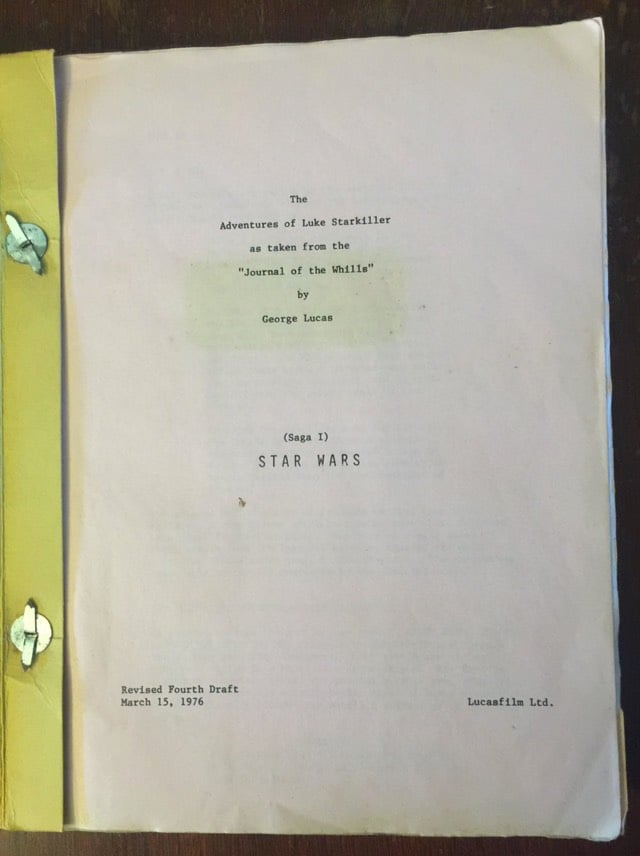
Peter Mayhew, who plays Chewbacca in Star Wars, is tweeting out photos of his original Star Wars script from March 1976. As you can see, it was originally called “The Adventures of Luke Starkiller as taken from the ‘Journal of the Whills’”. So catchy…why’d they change it, d’ya think?
If: 1) you’ve got a lake with not-so-thick ice on it, and 2) there’s a steady wind blowing toward the shore, you get this cool ice-stacking effect on the shore. This particular video was taken on the shore of Lake Superior near Duluth, MN. Be sure to listen to the sound as well. Crackly!
From as far back as 1927, when the award was for “Best Engineering Effects”, here’s a list of all the films that have won an Academy Award for Best Visual Effects. Among the winners were Alien (x2), Titanic, Star Wars (x3), Lord of the Rings (x3), Ben Hur, Benjamin Button, Gravity, and The Matrix.
As we saw in the crash test comparison of the 2009 Chevy Malibu and 1959 Chevy Bel Air, today’s cars are built with safety features like airbags and crumple zones to protect passengers from impacts. But as this crash test of a Ford Focus hatchback travelling at 120 mph shows, there’s not much you can do for passengers at that speed.
This Smart Car does pretty well at 70 mph though. (via @daveg)
Winners of the 2016 World Press Photo Contest. Some powerful stuff here.
IZ is an online clothing retailer catering to people in wheelchairs. The clothes are designed to be worn while seated and for ease of getting on and off. For instance this blazer is arch-cut in the back:

Pants are cut higher in the back to cut down on bunching in the front and riding down in the back and shirts are cut so that they drape right at the waist and hips.
![]()
Silicon Cowboys is an upcoming documentary about Compaq Computer, one of the first companies to challenge IBM with a compatible computer.
Launched in 1982 by three friends in a Houston diner, Compaq Computer set out to build a portable PC to take on IBM, the world’s most powerful tech company. Many had tried cloning the industry leader’s code, only to be trounced by IBM and its high-priced lawyers. SILICON COWBOYS explores the remarkable David vs. Goliath story, and eventual demise, of Compaq, an unlikely upstart who altered the future of computing and helped shape the world as we know it today. Directed by Oscar(R)-nominated director Jason Cohen, the film offers a fresh look at the explosive rise of the 1980’s PC industry and is a refreshing alternative to the familiar narratives of Jobs, Gates, and Zuckerberg.
There’s no trailer yet, but the film is set to debut at SXSW in March. The first season of Halt and Catch Fire had a lot of influences, but the bare-bones story was that of Compaq.
Many reviews mention the similarity of the characters to Apple founders Steve Jobs and Steve Wozniak, but the trio of managers from Texas Instruments who left to form Compaq in the early 80s are a much closer fit. The Compaq Portable was the first 100% IBM compatible computer produced.
Christopher Robbins recently interviewed Robert Caro (author of The Power Broker, perhaps the best book ever written about New York) for Gothamist. The interview is interesting throughout. (I lightly edited the excerpts for clarity.)
Caro: If you’re publishing on the Internet, do you call them readers or viewers?
Robbins: Either, I think.
Caro: How do you know they’re reading it?
Robbins: There’s something called Chartbeat — it shows you how many people are reading a specific article in any given moment, and how long they spend on that article. That’s called “engagement time.” We have a giant flatscreen on the wall that displays it, a lot of publications do.
Caro: What you just said is the worst thing I ever heard. [Laughs]
That exchange makes a nice companion to Snapchat like the teens.
Caro: Moses came along with his incredible vision, and vision not in a good sense. It’s like how he built the bridges too low.
I remember his aide, Sid Shapiro, who I spent a lot of time getting to talk to me, he finally talked to me. And he had this quote that I’ve never forgotten. He said Moses didn’t want poor people, particularly poor people of color, to use Jones Beach, so they had legislation passed forbidding the use of buses on parkways.
Then he had this quote, and I can still hear him saying it to me. “Legislation can always be changed. It’s very hard to tear down a bridge once it’s up.” So he built 180 or 170 bridges too low for buses.
We used Jones Beach a lot, because I used to work the night shift for the first couple of years, so I’d sleep til 12 and then we’d go down and spend a lot of afternoons at the beach. It never occurred to me that there weren’t any black people at the beach.
So Ina and I went to the main parking lot, that huge 10,000-car lot. We stood there with steno pads, and we had three columns: Whites, Blacks, Others. And I still remember that first column — there were a few Others, and almost no Blacks. The Whites would be go on to the next page. I said, God, this is what Robert Moses did. This is how you can shape a metropolis for generations.
That’s something to remember the next time someone tries to rehabilitate Moses’ legacy. Not to mention this excerpt from The Power Broker:
Robert Moses had always displayed a genius for adorning his creations with little details that made them fit in with their setting, that made the people who used them feel at home in them. There was a little detail on the playhouse-comfort station in the Harlem section of Riverside Park that is found nowhere else in the park. The wrought-iron trellises of the park’s other playhouses and comfort stations are decorated with designs like curling waves.
The wrought-iron trellises of the Harlem playhouse-comfort station are decorated with monkeys.
And now I am filled with regret at never having read The Power Broker. I started it a couple times, but could never find the time to follow through. I wish it was available on the Kindle…a 1300-page paperback is not exactly handy to carry about and read. The unabridged audiobook is 66 hours long…and $72.
In an all-white room, mosquitoes are mated and the resulting larvae divided by sex. Workers whisk at stray mosquitoes with electrified tennis rackets — the kind you see in novelty stores, but which have sold out in mosquito-obsessed Brazil.
MIT Tech Review takes you inside the mosquito factory that could stop Zika and other diseases. (Add “working in a mosquito factory” to the list of jobs I’m glad I don’t have…)
In film and video, which way the characters move across the screen affects how the viewers think about those characters. Generally, left-to-right movement is viewed positively while movement the opposite way is viewed more negatively. In the video, they mention a piece Roger Ebert wrote on How to Read a Movie, which is worth a re-read even if you saw it here many years ago.
If you don’t have Netflix but want a taste of what everyone has been talking about for the past two months, the entire first episode of Making a Murderer is up on YouTube.
For an episode called The Fix, Radiolab explores what anti-addiction drugs are available and why they aren’t more widely known and used to treat alcoholism and drug addiction.
Reporter Amy O’Leary was fed up with her ex-boyfriend’s hard-drinking, when she discovered a French doctor’s memoir titled The End of My Addiction. The fix that he proposed seemed too good to be true. But her phone call with the doctor left her, and us, even more intrigued. Could this malady — so often seen as moral and spiritual — really be beaten back with a pill?
We talk to addiction researcher Dr. Anna Rose Childress, addiction psychologist Dr. Mark Willenbring, journalist Gabrielle Glaser, The National Institute of Health’s Dr. Nora Volkow, and scores of people dealing with substance abuse as we try to figure out whether we’re in the midst of a sea change in how we think about addiction.
The New Yorker had launched a TV show called The New Yorker Presents, available on Amazon Prime. The first two episodes feature directors Alex Gibney (Going Clear) and Steve James (Hoop Dreams).
We’re tremendously excited to share “The New Yorker Presents” with you, and we hope that you’ll watch the two new episodes that will be released each Tuesday for the next five weeks. The first of the episodes available today also includes a segment on the “Truman Show” delusion, in which people believe that they are constantly being filmed; a cartoon being drawn by Roz Chast; and a performance by Paul Giamatti as Honoré de Balzac drinking his fabled fifty daily cups of coffee. The second episode includes a documentary on youth bull riding, by Steve James; Edwidge Danticat’s essay “Black Bodies in Motion and in Pain”; and a visit to Atlantic City, with Nick Paumgarten.
This launch is actually a bit of a reboot…they did a pilot of The New Yorker Presents last January.
The US government is forcing Apple to backdoor encryption on the iPhone. They’re fighting it.
Architectures is a documentary series exploring the architecture of notable buildings and the architects who designed them.
Each 26-minute film in the series focuses on a single building chosen because of the pioneering role it has played in the evolution of contemporary architecture. Meticulously filmed, each building is explored in great detail and this in-depth examination highlights all the concerns that confronted the architect from the genesis of the project through to its completion.
I’ve embedded the first episode in the series above, an examination of The Dessau Bauhaus by Walter Gropius; the rest of the series is available on YouTube or on DVD. (via @BoleTzar)
We Can’t Live Without Cosmos is Konstantin Bronzit’s 15-minute short film nominated for a 2016 Academy Award in the animated short category. It is about two friends who dream of going into space together.
They’re best friends who revolve in the same centrifuge, swim in neighboring lanes, and read together at night. Their happiness and exuberance is infectious. It lifts the stone-faced scientists who track their progress; it even expresses itself in their space suits, which are winsomely shaped to accommodate their slightly different heads (one is square, the other rectangular). Even as they prepare for their high-tech journey, they embody old-fashioned, noble virtues: bravery, curiosity, strength, tenderness.
Huh. Hollywood has invented a new type of movie trailer: the “we just started filming and here’s 5 seconds of the film that’s basically the last 5 seconds of the previous film” trailer. And whaddya know, idiot bloggers will post it because Star Wars Rey Luke squeeeeeee!!
“Sine Cosine Tangent”. New fiction by Don DeLillo in The New Yorker this week.

This is a recent favorite of mine by Christoph Niemann, part of a series of six animations done for MoMA.
Xochitl tortilla chips are the worst. (I reluctantly agree. A+ in taste, D- in picking up guac.)
Adam Westbrook talks about Vincent van Gogh and the benefit of doing creative work without the audience in mind. Having never read Csikszentmihalyi’s Flow (I know, I know), I was unfamiliar with the word “autotelic”. From Wikipedia:
Mihaly Csikszentmihalyi describes people who are internally driven, and as such may exhibit a sense of purpose and curiosity, as autotelic. This determination is an exclusive difference from being externally driven, where things such as comfort, money, power, or fame are the motivating force.
Doug Belshaw has a bit more on autotelism and how it relates to education.
From PHD Comics, and explanation of what gravitational waves are and why their discovery is so important to the future of science. (via df)
Update: Brian Greene’s explanation of gravitational waves to Stephen Colbert is the best one yet:
Greene is great at explaining physics in terms almost anyone can understand. Even though it’s more than 15 years old now, his book, The Elegant Universe, still contains the best explanation of modern physics (quantum mechanics + relativity) I’ve ever read.
Today is my last day working out of the Buzzfeed office. The company is soon moving to new NYC digs, which seems like a good time for me to hop off. I was the company’s design advisor back when it started and have been working out of their offices since there were five of us holed up in a former Communist Party HQ we shared with several enthusiastic roach coworkers in Chinatown. It’s been a treat watching this ship rocket into the stratosphere from the inside.1 They’ve got offices all over the world now and are probably close to 1000 employees, perhaps more, most of whom had no idea why the guy sitting w/ the tech team surfed around on the web all day and never attended any meetings.
Anyway, so many thanks to Jonah and the rest of the crew there. And good luck!
I should probably write a book.↩
From Celia Gomez, a supercut of some of the most notable movie references from The Simpsons. The Simpsons came out when I was 16 and while I loved it immediately, the show started making a whole lot more sense after I watched The Godfather, Taxi Driver, Citizen Kane, and Dr. Strangelove in my 20s. Lots of Kubrick in the Simpsons.
In How We Got to Now, the TV series based on the book of the same name, Steven Johnson explains how the wine press was used to print books, which resulted in a surge in demand for reading glasses, which had yet more unintended effects.
Johnson calls this cascade of inadvertent invention the Hummingbird Effect.
This is how change happens in the natural world: sometime during the Cretaceous age, flowers began to evolve colors and scents that signaled the presence of pollen to insects, who simultaneously evolved complex equipment to extract the pollen and, inadvertently, fertilize other flowers with pollen.
Over time, the flowers supplemented the pollen with even more energy-rich nectar to lure the insects into the rituals of pollination. Bees and other insects evolved the sensory tools to see and be drawn to flowers, just as the flowers evolved the properties that attract bees. The symbiosis between flowering plants and insects that led to the production of nectar ultimately created an opportunity for much larger organisms — the hummingbirds — to extract nectar from plants, though to do that they evolved a extremely unusual form of flight mechanics that enable them to hover alongside the flower in a way that few birds can even come close to doing. In other words, they had to learn an entirely new way to fly.
In an interview with Popular Mechanics, Johnson shared another example:
At the start of the 20th century, in Brooklyn, a printer was doing full-color magazines. In the summer the ink didn’t set up properly. The printer hired a young engineer, Willis Carrier, to devise a way to bring down the temperature and humidity in the room. He built this contraption that made the printing possible. Then the workers were like, “I’m gonna have my lunch in the room with the contraption, it’s cool in there.” Carrier says, “Hmm, that’s interesting.” He sets up the Carrier Corporation, which air-conditions movie theaters, paving the way for the summer blockbuster. Before air conditioning, a crowded theater was the last place you wanted to go. After a/c, summer movies become part of the cultural landscape.
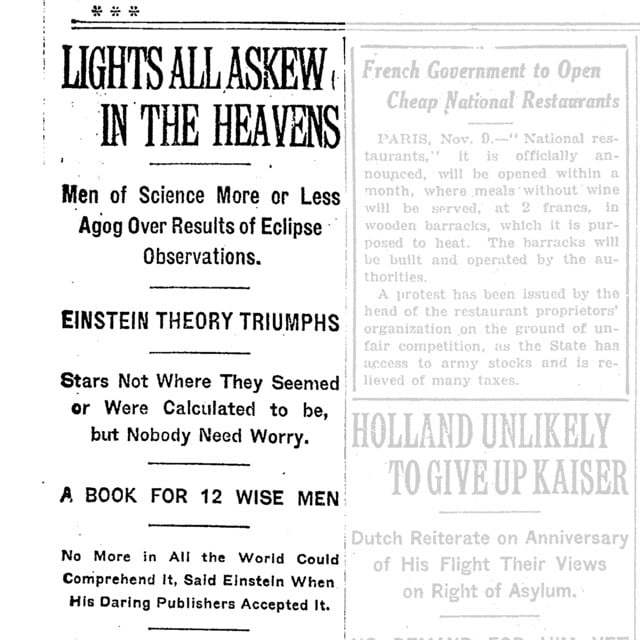
After a potential detection of gravitational waves back in 2014 turned out to be galactic dust, scientists working on the LIGO experiment have announced they have finally detected evidence of gravitational waves. Nicola Twilley has the scoop for the New Yorker on how scientists detected the waves.
A hundred years ago, Albert Einstein, one of the more advanced members of the species, predicted the waves’ existence, inspiring decades of speculation and fruitless searching. Twenty-two years ago, construction began on an enormous detector, the Laser Interferometer Gravitational-Wave Observatory (LIGO). Then, on September 14, 2015, at just before eleven in the morning, Central European Time, the waves reached Earth. Marco Drago, a thirty-two-year-old Italian postdoctoral student and a member of the LIGO Scientific Collaboration, was the first person to notice them. He was sitting in front of his computer at the Albert Einstein Institute, in Hannover, Germany, viewing the LIGO data remotely. The waves appeared on his screen as a compressed squiggle, but the most exquisite ears in the universe, attuned to vibrations of less than a trillionth of an inch, would have heard what astronomers call a chirp — a faint whooping from low to high. This morning, in a press conference in Washington, D.C., the LIGO team announced that the signal constitutes the first direct observation of gravitational waves.
The NY Times headline above is from when the concept of gravitational lensing suggested by Einstein’s theory of relatively was confirmed in 1919. I thought it was appropriate in this case. Wish they still ran headlines like that.
Update: The LIGO team has detected gravitational waves a second time.
Today, the LIGO team announced its second detection of gravitational waves-the flexing of space and time caused by the black hole collision. The waves first hit the observatory in Livingston, Louisiana, and then 1.1 milliseconds later passed through the one in Hanford, Washington.
By now, those waves are 2.8 trillion or so miles away, momentarily reshaping every bit of space they pass through.
From a small booklet written by Nelson Ross in 1928, a guide on How to Write Telegrams Properly.
Handwriting in Telegrams — There is a classic joke of the telegraph business which may not be out of place here. A lady, filing a message with the counter clerk for transmission, first enclosed it in an envelope. When the clerk tore open the envelope to prepare the telegram for sending, she reached for it indignantly with the exclamation: “The idea! That is my personal telegram and I don’t want anyone else to see it.”
It must be remembered that a telegram is transmitted letter by letter. Telegraph operators, like post office employees, are expert in reading handwriting, but even so, words cannot be guessed at. If you write the word “opportunity” very clearly as far as “oppo” and the rest of the word is a mere scribble, it cannot be transmitted in that fashion. It must be “opportunity” or nothing. If you sign your name “John” followed by a series of hen tracks, neither can that be transmitted. You may have intended the word for “Johnson,” but you cannot reasonably expect the telegraph employee to be a mind reader as well as an operator.
How did telegrams hit moving targets? Like so:
Messages for Persons on Trains — A message addressed to a passenger on a train should show the name of the railroad, train number or name or time due, place where the message is to be delivered, and also the point for which the passenger is bound. If the train is run in 13 sections, the section should be specified if known. A sample address is: “John Smith, en route Los Angeles, Care Conductor, Southern Pacific, Train 103, El Paso, Texas.” Even though when the train stop at El Paso and John Smith is paged, he may be pacing the Platform for fresh air and exercise, the conductor will strive hard to effect delivery. If you expect to have occasion to telegraph a friend setting out on a journey, it is a good idea to get from him his Pullman berth and car number, so that you will be able to indicate this on your telegram. Telegraph clerks generally will be found to be courteous in aiding you to determine the progress of the train and station where it most likely can be intercepted.
And sending money was possible as well, using the HTTPS of its time:
The procedure is simple. A person wishing to send a sum of money by wire merely calls at the telegraph office, fills out an application blank, and pays the clerk the amount to be sent and the fee for its transmittal. The telegraph companies have a secret code which they use in directing their agent in the distant city to make payment to the person designated. The payee is notified to call at the office for a sum of money, or a check is sent to the payee, as may be directed. It is optional with the sender of the money order, whether the payee shall be required to identify himself absolutely or whether identification shall be waived. The Western Union Telegraph Company alone handles more than $250,000,000 annually in telegraphic money orders.
I wonder what sort of shenanigans telegraph hackers got up to trying to intercept those “secret codes” and make fake payouts. See also The Victorian Internet.
Laura June likes Bernie Sanders in many ways but is going to vote for Hillary Clinton because Clinton is a woman.
As with many issues that stem from the fact of my motherhood — breast-feeding, co-sleeping — I speak only for myself, and cannot generalize my experience from “I am” to “you should.” I only know in my heart that I simply don’t want my daughter to grow up in a world where a woman has never been president. And if not now, when?
I’m a woman, and a mother, and I’m voting for Hillary Clinton for my daughter, and for her future.
If I had a vote to cast in the upcoming NY Democratic primary, I would also vote for Hillary Clinton and also because she is a woman. I believe the most important and longest-lasting effect of Barack Obama’s election in 2008 is that tens of millions of kids (of all racial backgrounds) got to experience an African American being President. Those kids are going to grow up knowing, and not just theoretically, that a non-white person can be elected (and even re-elected) President of the United States. Clinton’s election would send a similar message to those same kids (both girls and boys): a woman can be elected President. I think it would have a huge future effect, more than any of the policy differences between her and Sanders, especially back-to-back with an Obama presidency.

From Richard Grant, the real life story of Hugh Glass, who is played by Leonardo DiCaprio in The Revenant. As Grant allows, the story of Glass’s life is “a blend of history and mythology” and is only a little less plausible than the events of the movie (and the novel on which the movie is based).
The expedition leader, a terminally luckless man named Andrew Henry, assigned two hunters to travel ahead of the main group. Most historians think that Hugh Glass was not one of them, because these northern plains and mountains were a new environment to him, and other men had more experience hunting here. But Glass was a loner by nature and stubborn as they come, and it seems clear that he was off breaking orders, hunting by himself when he surprised a huge female grizzly bear with cubs.
She might have weighed 500 pounds, even 800 is not inconceivable. He shot her as she charged, but as he surely knew, even a .53 calibre rifle ball was unlikely to stop an enraged grizzly. She ripped his scalp to ribbons with her three-inch claws and shredded his throat. Accounts of the mauling vary slightly, but all agree that Glass was “tore nearly all to peases”, as one mountain man later recorded. There were deep lacerations on his back, his face, one leg, his chest and one shoulder and arm. In Michael Punke’s book, based on Glass’s life, she picks him up in her teeth and shakes him. Most versions of the story have the dead bear, having finally succumbed to the rifle wound, lying on top of the half-dead Glass.
I saw The Revenant two weeks ago and thought it was good but not great. Underwhelmed, I guess I’d say. As usual, Leo was too distracting as himself to fully blend into the rest of the movie…Leo’s DiCaprio-ness always breaks the fourth wall for me.
On Twitter this morning, Little Brown UK announced that they will be publishing an 8th Harry Potter book called Harry Potter and Cursed Child. The book is the rehearsal script of the play of the same name co-written by Rowling. Which is a bit disappointing, to be honest…play scripts are not fully-formed books. Anyway, from the play’s website, here’s the vague plot:
It was always difficult being Harry Potter and it isn’t much easier now that he is an overworked employee of the Ministry of Magic, a husband and father of three school-age children.
While Harry grapples with a past that refuses to stay where it belongs, his youngest son Albus must struggle with the weight of a family legacy he never wanted. As past and present fuse ominously, both father and son learn the uncomfortable truth: sometimes, darkness comes from unexpected places.
Even though employees are probably still in their jammies at home, you can already pre-order the book on Amazon. (via mic)
This Russian truck is mostly tires, which gives it a short turning radius, cuteness,1 and the ability to swim. Yep, you can drive it right into a lake. Jalopnik has more details, including the truck’s surprisingly pint-sized engine:
It weighs just 2,866 pounds dry, so while it might only have a 44.3 horsepower 1.5 liter Kubota V1505 four-cylinder diesel linked to a five-speed manual, it will still do 28 mph on land, or 3.7 mph in water, depending on the wind. It will also crawl at up to 9.3 mph in first gear.
(via digg)
The oversized tires on the normal-sized frame have a similar effect as large eyes on a cartoon character do.↩
I really enjoyed this piece by Catherine Nichols about a literary technique invented by 19th century female novelists that she calls adaptation.
Adaptation is a kaleidoscopic way of understanding human nature, and a novelistic technique for showing that character isn’t fixed. In real life, people change constantly, depending on who’s in the room, or what they’ve each understood of the others’ nature and mood.
Here’s an example from Pride and Prejudice:
The first time Mr. Darcy tries to express his interest in Elizabeth, he asks her to dance, and she refuses. Later, he sees her reading, and he comments to other people in the room that reading is important and his library is huge. Really great library at Darcy’s house. Elizabeth, however, doesn’t take the hint. Any shy person might recognize the arrows in his flirting quiver-standing around near her and saying to his friends that he likes the things that he thinks she likes. It’s as effective for him as it usually is for the rest of us; she doesn’t know, or doesn’t want to, that flirting is taking place.
Then, the next time Mr. Darcy is alone with Elizabeth and his friends, he adapts. He makes an unflattering observation about Mr. Bingley’s personality, offered to Elizabeth as a gift. He’s changing his approach based on a comment she made in the previous scene. He can only change within the range of his own character, which is shy (he’d never say this in another context), clever (no one fully gets the insult except for Elizabeth), and sort of mean. It’s an incredibly efficient scene, and it’s how Darcy, a man with few lines and no third person narration spilling his secrets, can be as well-developed a character as Elizabeth herself.
For my money, P&P is one of best novels of all time. The adaptation technique goes a long way toward explaining why it’s such an effective lens into human nature.

Buzzfeed’s Ben Rosen recently got a lesson from his 13-year-old sister Brooke about how she and her friends use Snapchat. Some highlights:
I would watch in awe as she flipped through her snaps, opening and responding to each one in less than a second with a quick selfie face. She answered all 40 of her friends’ snaps in under a minute.
I assume this is a slight exaggeration, but even 40 replies in 2 minutes is an insane pace.
BROOKE: My new account? About a month and a half.
ME: New account?
BROOKE: Yeah, I didn’t like my old name, so I made a new account.
Fluid identity, check. I have had the same email address and username on any and all new services since the 90s.
BROOKE: No conversations…it’s mostly selfies. Depending on the person, the selfie changes. Like, if it’s your best friend, you make a gross face, but if it’s someone you like or don’t know very well, it’s more regular.
ME: I’ve seen how fast you do these responses… How are you able to take in all that information so quickly?
BROOKE: I don’t really see what they send. I tap through so fast. It’s rapid fire.
Response as message. Virtual eye contact. Like liking or faving. This reminds me of Matt Webb’s Glancing project. I’m ok, you’re ok. Virtual primate social grooming.
BROOKE: Yeah. This one girl I know uses 60 gigabytes [of cellular data] every month.
I use 60 Gb of data per year. If that. Do teens not know about wifi?
ME: How often are you on Snapchat?
BROOKE: On a day without school? There’s not a time when I’m not on it. I do it while I watch Netflix, I do it at dinner, and I do it when people around me are being awkward. That app is my life.
ME: What the hell is a NARP?
BROOKE: Nonathletic Regular Person. NARP.
I am looking forward to working for Brooke when she’s 24. She’s clearly going to be in charge.
BROOKE: If you want to take a screenshot without your friend knowing, turn on airplane mode, take the screenshot, log out of the app immediately, turn off airplane mode, and then load the app back up.
Up up down down left right left right B A.
Update: I’ve seen a few people saying that how Brooke and her friends use Snapchat is how adults should be or will be using social media in the future. I don’t think that’s right. How teens use Snapchat is how many teens use anything they are intensely interested in and/or keep them in contact with their friends. Adults probably cannot and will not use Snapchat like this. They have different priorities.1 Go read the Buzzfeed piece again…it’s all about social status, something 13-year-olds care about very much, perhaps more than anything. “That app is my life” is not an exaggeration or an over-dramatization.
Back in the day — and I’m talking about around the invention of farming and even further back — everyone you knew in the entire world was never more than a few hundred feet from you for more than a few days. Wheels, domesticated crops & animals, industrialization, cars, and airplanes made it so that people could live farther and farther apart from each other, which is weird for social animals like humans and particularly difficult for teenagers for whom that social connection is the most important thing in their lives.
Smartphones, Instagram, Snapchat, and generous data plans have closed that distance again in many ways…or more precisely, have made the distance less relevant. Interacting with 190 friends1 dozens or even hundreds of times a day probably feels a lot like being back in a hunter/gatherer band, socially speaking. Thanks to these magic pocket-sized rectangles, everyone you know in the world is never more than a few seconds away for more than a few hours.
Think about how teens used malls in the 80s and 90s as a social device. Adults didn’t use malls like that…it didn’t make sense in their lives. Malls were for shopping, eating, and maybe seeing a movie. Functional stuff. The intense social stuff happened mainly elsewhere: at work, at home, or at bars/clubs/restaurants/church/etc.↩
Note how close Brooke’s number of friends (180 or 190) is to Dunbar’s number, a proposed cognitive limit for stable social group sizes, and to the estimates of how big various hunter-gatherer societies were. That’s interesting, right?↩
Here are some clips taken from Life on Air, a 2002 BBC documentary celebrating David Attenborough’s 50 years on television. The entire show is available here. (via @dunstan)

If you’re forced into playing Monopoly by friends, you can employ this simple strategy to ensure they will never ever ask you to play again.
With a second monopoly completed, your next task is to improve those properties to three houses each, then all of your properties to four houses each. Six properties with three houses will give you more than half of the houses in the game, and four houses each will give you 75% of the total supply. This will make it nearly impossible for your opponents to improve their own property in a meaningful way. Keep the rulebook nearby once the supply gets low, as you will undoubtedly be questioned on it. At this point, you will be asked repeatedly to build some friggin’ hotels already so that other people can build houses. Don’t.
At this point, you more or less have the game sewn up. If losing a normal game of monopoly is frustrating, losing to this strategy is excruciating, as a losing opponent essentially has no path to victory, even with lucky rolls. Your goal is to play conservatively, lock up more resources, and let the other players lose by attrition. If you want to see these people again, I recommend not gloating, but simply state that you’re playing to win, and that it wasn’t your idea to play Monopoly in the first place.
It is difficult to read this without thinking about income inequality in the real world.
Amanda Hesser and Merrill Stubbs of Food52 are coming out with a new book called A New Way to Dinner.
A smart, inspiring cookbook of 100+ recipes from the founders of the powerhouse web site Food52 showing just how they — two busy working parents — actually plan, shop, and cook for delicious dinners (and breakfasts, lunches, and desserts) — all through the week. The secret? Cooking ahead.
I need this. I want to cook more, eat better, and not dine out so much, but I just haven’t been able to get it together. And I love the title…”dinner” cleverly works both as a noun and a verbed noun.
Soylent Dick. This is totally inappropriate genius.
This short student film follows a stone through many millions of years, from a large mountain to a grindstone to a cannonball and beyond. See also Al Jarnow’s Cosmic Clock. (via @mikesheffernj)
Happy Friday, everyone. I am so glad this week is done. I have no idea what this is. But it made me happy briefly and that’s enough. (via @jasonzada)
I rolled my eyes so hard reading this, they rolled right out of my head. Now they’re blocks away. Bye, eyes!
For her new book, Ariel Waldman asked dozens of astronauts about their experiences in space.
With playful artwork accompanying each, here are the real stories behind backwards dreams, “moon face,” the tricks of sleeping in zero gravity and aiming your sneeze during a spacewalk, the importance of packing hot sauce, and dozens of other cosmic quirks and amazements that come with travel in and beyond low Earth orbit.
Waldman is the co-creator of the very cool spaceprob.es.
Update: This book is now out, shipping, released…launched, if you will.
Noela Rukundo, whose husband had only recently paid to have killed, showed up at her own funeral.
Finally, she spotted the man she’d been waiting for. She stepped out of her car, and her husband put his hands on his head in horror.
“Is it my eyes?” she recalled him saying. “Is it a ghost?”
“Surprise! I’m still alive!” she replied.
Far from being elated, the man looked terrified. Five days earlier, he had ordered a team of hit men to kill Rukundo, his partner of 10 years. And they did - well, they told him they did. They even got him to pay an extra few thousand dollars for carrying out the crime.
Now here was his wife, standing before him. In an interview with the BBC on Thursday, Rukundo recalled how he touched her shoulder to find it unnervingly solid. He jumped. Then he started screaming.
What a story. As @tcarmody says, “I like to imagine Bezos grinning and salivating over this story like Charles Foster Kane”.
Bill Wurtz’s History of Japan is the most entertaining history of anything I have ever seen.
The Economist style guide’s section on Americanisms is just a tad catty.
Try not to verb nouns or to adjective them. So do not access files, haemorrhage red ink (haemorrhage is a noun), let one event impact another, author books (still less co-author them), critique style guides, pressure colleagues (press will do), progress reports, source inputs, trial programmes or loan money. Avoid parenting and, even more assiduously, parenting skills. Gunned down means shot. And though it is sometimes necessary to use nouns as adjectives, there is no need to call an attempted coup a coup attempt, a suspected terrorist a terrorist suspect or the Californian legislature the California legislature. Vilest of all is the habit of throwing together several nouns into one ghastly adjectival reticule: Texas millionaire real-estate developer and failed thrift entrepreneur Hiram Turnipseed…
(via @mccanner)
Awesome, they’re putting in a protected bike lane on 6th Ave in NYC. Now do 5th Ave (which is where I got hit).
“I’m looking at a picture of two mice. The one on the right looks healthy. The one on the left has graying fur, a hunched back, and an eye that’s been whitened by cataracts.”
What’s the difference? Well, scientists at the Mayo clinic used a process to remove senescent (or retired) cells from one of them. And that process leads to mice who age better and live longer. As one researcher not connected to the study explains:
The usual caveats apply — it’s got to be reproduced by other people — but if it’s correct, without wanting to be too hyperbolic, it’s one of the more important aging discoveries ever.
What a great idea. I just wish it were better executed. The weird music they use for the end credits of each movie is too much…it would have been better to just play it straight and let the gag stand by itself. (via cynical-c)
Frinkiac searches through the subtitles from every episode of The Simpsons (in the first 15 seasons) and returns screencaps of all the times when the search term was used. For example, inanimate:
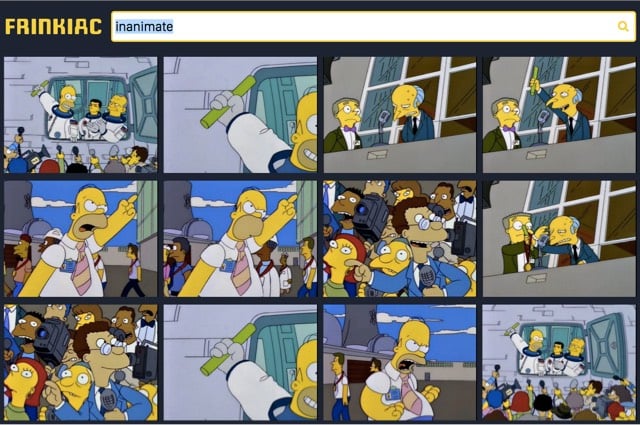
(via @emunn)
Update: Hi diddley ho! The Frinkiac now does animated GIFs. Like this one. (via @buzz)
You’re probably familiar with Aaron James Draplin through his work on Field Notes. Well, as his upcoming book shows, Draplin is an uncommonly prolific designer who has done a ton of amazing work.
Pretty Much Everything is a mid-career survey of work, case studies, inspiration, road stories, lists, maps, how-tos, and advice. It includes examples of his work — posters, record covers, logos — and presents the process behind his design with projects like Field Notes and the “Things We Love” State Posters. Draplin also offers valuable advice and hilarious commentary that illustrates how much more goes into design than just what appears on the page. With Draplin’s humor and pointed observations on the contemporary design scene, Draplin Design Co. is the complete package for the new generation of designers.
I’ve been a fan of his for a long time…this is an easy purchase.
Artist Jill Pelto turns climate change graphs into art. So, for instance, a chart of rising global temperatures turns into a forest fire, which are becoming more common as temps rise:

And a graph of the retreat of glaciers over the years becomes a retreating glacier:

(via @EricHolthaus & climate central)
Until recently, the Syrian city of Homs was the country’s third largest, with an estimated population of more than 800,000. As you can see from this drone footage, The Siege of Homs left much of the city destroyed and its population displaced.
If you scroll down in this Guardian piece, there’s a photo showing what a Homs street looked like before and after the siege. (via @alexismadrigal)
Update: A pair of newlyweds recently posed for some wedding portraits in war-ravaged Homs. Bad idea or the worst idea?
The thing these three Russian women do starting at about 0:45 and continuing until about 1:20, is just flat-out amazing. Just watch. (via @dunstan)
The American Slave Coast: A History of the Slave-Breeding Industry by Ned & Constance Sublette is a book which offers an alternate view of slavery in the United States. Instead of treating slavery as a source of unpaid labor, as it is typically understood, they focus on the ownership aspect: people as property, merchandise, collateral, and capital. From a review of the book at Pacific Standard:
In fact, most American slaves were not kidnapped on another continent. Though over 12.7 million Africans were forced onto ships to the Western hemisphere, estimates only have 400,000-500,000 landing in present-day America. How then to account for the four million black slaves who were tilling fields in 1860? “The South,” the Sublettes write, “did not only produce tobacco, rice, sugar, and cotton as commodities for sale; it produced people.” Slavers called slave-breeding “natural increase,” but there was nothing natural about producing slaves; it took scientific management. Thomas Jefferson bragged to George Washington that the birth of black children was increasing Virginia’s capital stock by four percent annually.
Here is how the American slave-breeding industry worked, according to the Sublettes: Some states (most importantly Virginia) produced slaves as their main domestic crop. The price of slaves was anchored by industry in other states that consumed slaves in the production of rice and sugar, and constant territorial expansion. As long as the slave power continued to grow, breeders could literally bank on future demand and increasing prices. That made slaves not just a commodity, but the closest thing to money that white breeders had. It’s hard to quantify just how valuable people were as commodities, but the Sublettes try to convey it: By a conservative estimate, in 1860 the total value of American slaves was $4 billion, far more than the gold and silver then circulating nationally ($228.3 million, “most of it in the North,” the authors add), total currency ($435.4 million), and even the value of the South’s total farmland ($1.92 billion). Slaves were, to slavers, worth more than everything else they could imagine combined.
Just reading that turns my stomach. The Sublettes also recast the 1808 abolition of the transatlantic slave trade as trade protectionism.
Virginia slaveowners won a major victory when Thomas Jefferson’s 1808 prohibition of the African slave trade protected the domestic slave markets for slave-breeding.
I haven’t read the book, but I imagine they touched on the fact that by growing slave populations, southern states were literally manufacturing more political representation due to the Three-Fifths clause in the US Constitution. They bred more slaves to help politically safeguard the practice of slavery.
Update: Because slaves were property, Southern slave owners could mortgage them to banks and then the banks could package the mortgages into bonds and sell the bonds to anyone anywhere in the world, even where slavery was illegal.
In the 1830s, powerful Southern slaveowners wanted to import capital into their states so they could buy more slaves. They came up with a new, two-part idea: mortgaging slaves; and then turning the mortgages into bonds that could be marketed all over the world.
First, American planters organized new banks, usually in new states like Mississippi and Louisiana. Drawing up lists of slaves for collateral, the planters then mortgaged them to the banks they had created, enabling themselves to buy additional slaves to expand cotton production. To provide capital for those loans, the banks sold bonds to investors from around the globe — London, New York, Amsterdam, Paris. The bond buyers, many of whom lived in countries where slavery was illegal, didn’t own individual slaves — just bonds backed by their value. Planters’ mortgage payments paid the interest and the principle on these bond payments. Enslaved human beings had been, in modern financial lingo, “securitized.”
Slave-backed securities. My stomach is turning again. (via @daveg)
Update: Tyler Cowen read The American Slave Coast and listed a few things he learned from it.
2. President James Polk speculated in slaves, based on inside information he obtained from being President and shaping policy toward slaves and slave importation.
3. In the South there were slave “breeding farms,” where the number of women and children far outnumbered the number of men.
Update: In his book The Half Has Never Been Told: Slavery and the Making of American Capitalism, Edward Baptist details how slavery played a central role in the making of the US economy.
As historian Edward Baptist reveals in The Half Has Never Been Told, slavery and its expansion were central to the evolution and modernization of our nation in the 18th and 19th centuries, catapulting the US into a modern, industrial and capitalist economy. In the span of a single lifetime, the South grew from a narrow coastal strip of worn-out tobacco plantations to a sub-continental cotton empire. By 1861 it had five times as many slaves as it had during the Revolution, and was producing two billion pounds of cotton a year. It was through slavery and slavery alone that the United States achieved a virtual monopoly on the production of cotton, the key raw material of the Industrial Revolution, and was transformed into a global power rivaled only by England.
(via @alexismadrigal)
Um, spoilers. Their picks include 2001, Gangs of New York, The 400 Blows, and Inception. I really thought Cache would be on the list.
Lego and Disney are teaming up for a Star Wars: The Force Awakens video game, out this summer. The trailer for it is possibly more fun than the movie was and is well worth watching if you enjoyed The Lego Movie.
Twitter user @dilsexia posted the first one with the caption “The Revenant”:

Polish blogger Dawid Adamek ran with the idea and created several more Pooh/Oscar mashups:
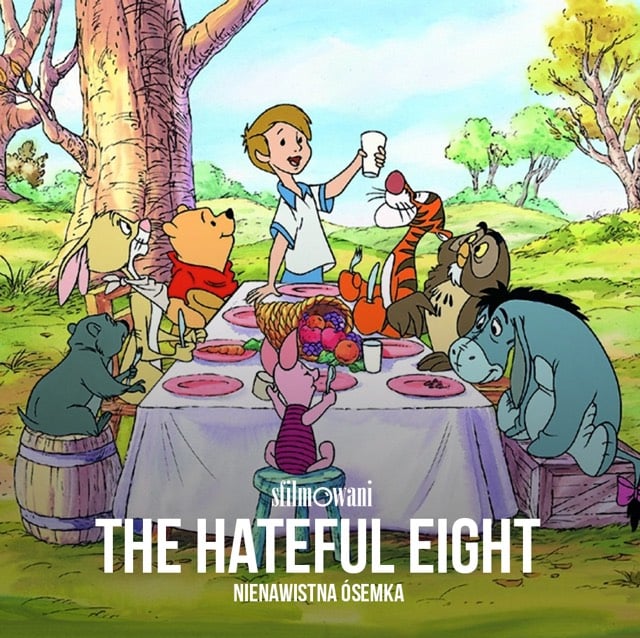
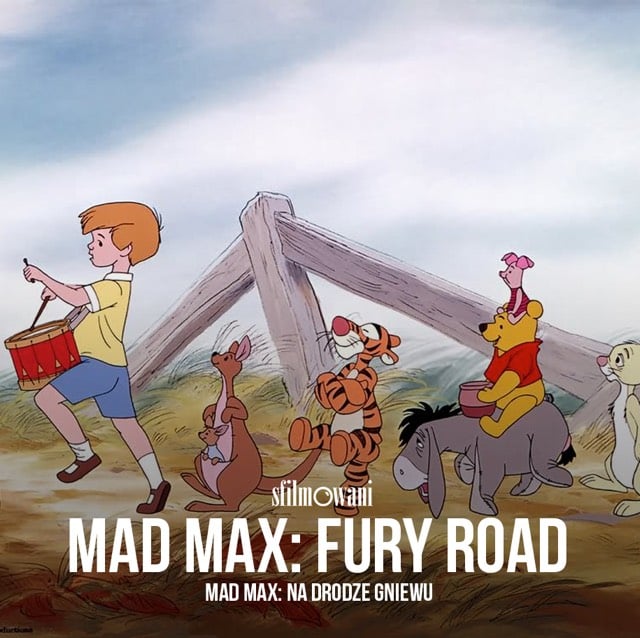
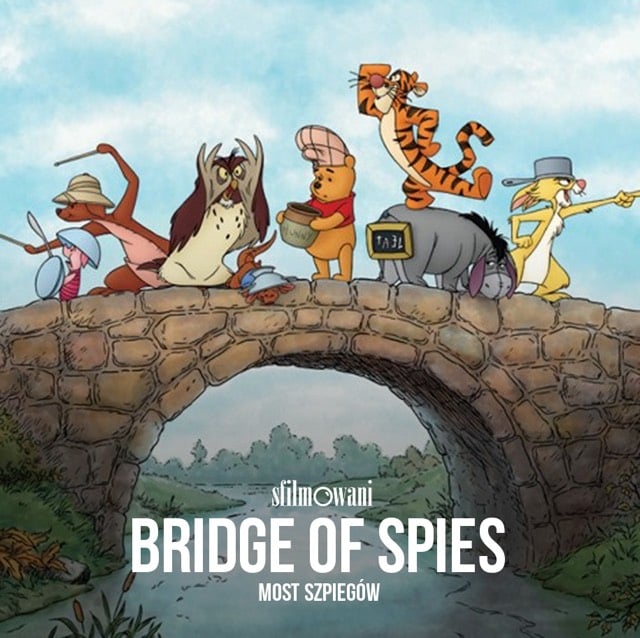

Somehow, this woman seems to be spinning both clockwise and counter-clockwise simultaneously. This is worse than the spinning ballerina. Anyone know who did this? Randomly found it on Facebook and couldn’t trace the source back…
Sesame Workshop (producer of Sesame Street) is launching a VC arm to fund kid-focused tech companies
Surprise! A new show by Louis CK (he stars w/ Steve Buscemi) called Horace and Pete, available only on his website
David Foster Wallace’s Infinite Jest turns 20 years old this month. To mark the occasion, the Harry Ransom Center, home of DFW’s archive of papers, is posting some of the more interesting findings by visiting scholars. Here, for instance, is a letter written by Wallace to his editor a few months before IJ’s publication.
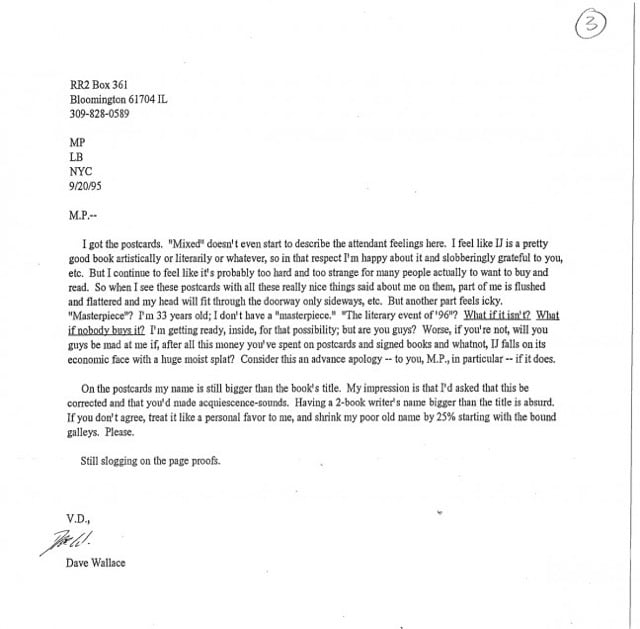
(via @john_overholt)
Update: In a NY Times essay adapted from his forward to an upcoming 20th anniversary edition of IJ, Tom Bissell reflects on why Infinite Jest still resonates 20 years later.
In interviews, Wallace was explicit that art must have a higher purpose than mere entertainment: “Fiction’s about what it is to be a … human being.” And here, really, is the enigma of David Foster Wallace’s work generally and “Infinite Jest” specifically: an endlessly, compulsively entertaining book that stingily withholds from readers the core pleasures of mainstream novelistic entertainment, among them a graspable central narrative line, identifiable movement through time and any resolution of its quadrumvirate plotlines. “Infinite Jest,” in other words, can be exceedingly frustrating. To fully understand what Wallace was up to, the book bears being read, and reread, with Talmudic focus and devotion. For many Wallace readers this is asking too much. For many Wallace fans this is asking too much.
Remy Porter hates The Lord of the Rings because it feels too much like work, too much like “every crappy enterprise IT project”. The tale begins with Gandalf, a legacy systems developer who pushes off important work onto Bilbo, who reluctantly became a developer after becoming proficient at spreadsheet macros. I wasn’t expecting too much from this video b/c of the title, but it’s a surprisingly entertaining analogy.
Stay Connected